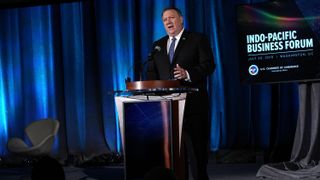The economic arm of the US’ Indo-Pacific strategy
In a speech to the Indo-Pacific Business Forum on 30 July, Secretary of State Mike Pompeo unveiled the first new economic offerings of the Trump administration’s Free and Open Indo-Pacific strategy. Pompeo’s remarks on America’s “Economic Vision” follow President Trump’s hints at the APEC CEO Summit last November about an economic strategy based on “reciprocity”, sovereignty, and a large role for private industry. Pompeo made explicit the ethos of the administration’s initiative, stating “the great theme of our engagement is this: Where America goes, we seek partnership not domination”.
The centrepiece of Pompeo’s announcement was a new US$113 million (AUD$153.5m) in funding for technology, energy, and infrastructure projects in the Indo-Pacific. Of these funds, $25 million will be dedicated to a Digital Connectivity and Cybersecurity Partnership to improve communications infrastructure, promote digital regulatory policies and build cybersecurity capacity. A further $50 million will go to ASIA EDGE (Enhancing Development and Growth through Energy) to assist partners to import, produce, and deploy energy resources. The funding package will also include support for regional institutions including ASEAN and the Indian Ocean Rim Association.
Of perhaps the greatest interest to Australia, the United States will launch an Infrastructure Transaction and Assistance Network and an Indo-Pacific Transaction Advisory Fund worth $30 million to “boost the development of infrastructure done right” and help partner countries to access independent legal and financial advisory services. Characterised by most commentators as a rival to China’s Belt and Road Initiative (BRI), these funds are designed to promote infrastructure that “advances national sovereignty, regional integration and trust” and avoids ‘strings attached’, poor quality investment that ensnares states in unsustainable debt traps.
Pompeo claimed that “these funds represent just a down payment on a new era in US economic commitment to peace and prosperity in the Indo-Pacific region”. Indeed, in the same speech Pompeo announced two further US investments: the Millennium Challenge Corporation’s $350 million agreement with the Mongolian Government to improve water security, and a hundred-million-dollar investment in transport in Sri Lanka, which is in the process of finalisation.
The Trump administration anticipates that these programs will be coordinated by a new development finance institution (created by the merger of OPIC and other existing bodies) as envisaged by the BUILD Act currently before the Senate.
What is OPIC?
The Overseas Private Investment Corporation (OPIC) is the US government’s current development finance institution. It offers guidance and support, including financing and political risk insurance, to private US companies investing in development projects overseas. OPIC therefore achieves the twin goals of encouraging private sector investment and furthering international development. It is a self-sustaining initiative that operates at no cost to the taxpayer and has contributed US$3.7 billion to deficit reduction over the past decade.
OPIC’s existence came under threat in early 2017 with its international focus appearing incongruous with Trump’s ‘America first’ philosophy.
One example of OPIC’s work is the $3.7 million loan it provided to Big Tree Farms, a US company that produces coconut products such as coconut water, to invest in coconut agriculture across Indonesia including expanding processing and production centres and providing farmer training in sustainable land use.
OPIC’s existence came under threat in early 2017 with its international focus appearing incongruous with Trump’s ‘America first’ philosophy. Although the FY2018 budget called for OPIC’s elimination, in the wake of Trump’s National Security Strategy (NSS) OPIC’s executive vice-president David Bohigian has claimed “there’s a realisation throughout Washington that development, defence and diplomacy need to work hand in hand.”
What is the BUILD Act?
The Better Utilisation of Investments Leading to Development (BUILD) Act is a bipartisan piece of legislation first introduced to Congress in February 2018. Its principal aim is to consolidate the numerous government agencies that support private-sector based development (including OPIC and USAID’s Development Credit Authority) into a single agency to allow for greater operational efficiency and effectiveness.
The Act would create the US International Development Finance Corporation (USIDFC), which, according to Pompeo, would result in the US government’s development finance capacity doubling to US$60 billion. USIDFC would allegedly strengthen Washington’s ability to promote strategic investment in the Indo-Pacific, advancing US government national security, as well as development, objectives. The National Security Strategy states that “modernised development finance tools can promote stability, prosperity, and political reform”.
The proposed merger now has the strong backing of the White House. At the APEC CEO Summit last year, Trump stated that the United States is “committed to reforming our development finance institutions” so that they better incentivise private sector investment in Asia and “provide strong alternatives to state-directed initiatives”. In his Indo-Pacific Business Forum speech, Pompeo stated that he was “proud” to support the BUILD Act and noted that the ‘Free and Open Indo Pacific’ strategy was a “truly whole of government mission”.
On 17 July the BUILD Act passed the House of Representatives. Given the Act’s wide support in both the House Foreign Affairs Committee and the Senate Foreign Relations Committee it seems likely that the Act will also pass the Senate.
The role for Australia
Pompeo’s promotion of these developments in US infrastructure financing came in the same week as Julie Bishop’s office announced a trilateral partnership between Australia, the United States and Japan to coordinate infrastructure investment in the Indo-Pacific. The trilateral will target investment projects in the energy, transportation, tourism and technology sectors that “drive economic growth, create opportunities and foster a free, open, inclusive and prosperous Indo-Pacific”. Trilateral investment will hence be characterised by transparency, sustainability, quality standards, employment of the local workforce, and the attraction of private capital.
China’s prolific spending as part of the BRI has not displaced Australia’s status as the largest aid donor in the Pacific.
As Australia lacks a dedicated development finance organisation like OPIC or Japan’s ‘Japanese Bank for International Cooperation’ (JBIC), Australia’s involvement will be coordinated by the Department of Foreign Affairs and Trade. At the time of writing, no specifics have been released regarding how much Australia will contribute financially to the scheme, nor how the partnership will work in practice. The press release simply states that details will be formalised “in due course”.
Nevertheless, increased attention on regional infrastructure complements the Australian government’s stated foreign policy goals. A “stable and prosperous” Indo-Pacific is the cornerstone of the government’s 2017 Foreign Policy White Paper. The White Paper also flagged intensified Pacific engagement as a central objective and recognised the “massive and wide-ranging” need for infrastructure. China’s prolific spending as part of the BRI has not displaced Australia’s status as the largest aid donor in the Pacific. Australia has stepped up its commitment to the region and in April reached an agreement with the Solomon Islands to build an undersea internet cable between the two nations and Papua New Guinea.
Infrastructure: the new vogue
The US$113m package from the US government and the Australia-Japan-US trilateral partnership are not the only large scale or multilateral infrastructure initiatives announced this year. At the ASEAN-Australia Special Summit in March, Malcolm Turnbull unveiled the “ASEAN-Australia Infrastructure Cooperation Initiative” which seeks to establish a pipeline of regional projects and source private and public funding. During the Summit Julie Bishop also confirmed that the G20 Global Infrastructure Hub would link with ASEAN to channel public-private-partnerships into infrastructure investment.
In April, the United States, Japan, and India formed a partnership to cooperate on infrastructure projects in South Asia. OPIC, JBIC and India’s Nippon Export and Investment Insurance will share information on sponsored projects and consider joint ventures as well as offering grants, loans, and insurance to assist local companies to invest in ports, power plants and industrial parks in Nepal, Bangladesh and Myanmar.
Between these projects and China’s BRI the Indo-Pacific will foreseeably enjoy a boom in infrastructure development. While interpreted by many as the latest manifestation of the geopolitical competition between the United States and China, the need for infrastructure is real and will continue: the Asian Development Bank estimates that the region requires US$26 trillion in the next 15 years to address the shortage. There is ample opportunity for Australia to contribute to Indo-Pacific development and harmonise investments with regional security goals.







